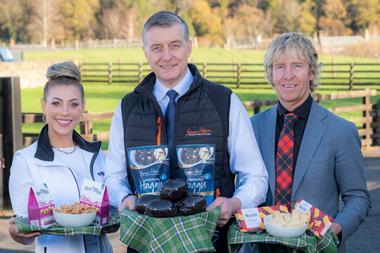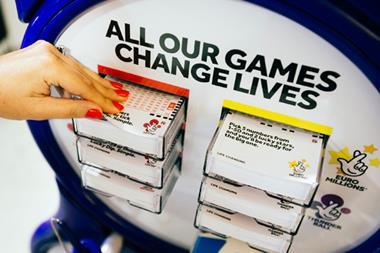Overall, these 50 grocery companies enjoyed a sales increase of nearly 6%, driven by both organic growth and acquisition. For the first time, their combined operating profit exceeded $100bn an average margin of 12% of sales.
Of course, the overall picture hides the stories of the many individual winners and losers. At the top end of the table, Philip Morris keeps its lead as the company with the highest sales. Even if excise duties were excluded from the table, it would still retain a comfortable lead over runner-up Nestlé. Last year was also a good year for Unilever. Its policy of rationalising product lines and focusing on leading brands appears to be paying off with both increased sales and operating margin.
For some companies this was a year for catching breath after the previous year's acquisition activity. Kellogg and PepsiCo completed the integration of Keebler and Quaker respectively, whilst Fort James enjoyed its first year as part of Georgia-Pacific.
Elsewhere, the M&A activity continued among the grocery giants. Tyson completed the takeover of IBP foods whilst the merger of Dean Foods and Suiza Foods increased scale enough to promote them into this year's Top 50.
Consolidation continued in the brewing industry with Interbrew continuing on their acquisition trail adding Becks to its portfolio.
The Diageo/Pernod Ricard takeover of Seagram had final approval with Diageo's disposal of brands as demanded by regulatory authorities. Elsewhere in the alcoholic drinks sector, within the last few months Scottish & Newcastle announced a bid for Finnish brewer Hartwall.
Not all firms had a successful year. Some American firms such as Heinz and Procter & Gamble found sales growth squeezed by unfavourable exchange rate movements, with the rising dollar turning overseas positive sales growth figures into dollar declines. Others increased sales but had profits reduced by declining margins. For example, Campbell Soup Company managed to reverse the previous year's sales decline, but the increased marketing investment required to do so hit earnings.
However, these difficulties pale in comparison with those faced by Snow Brand Milk Products. A food poisoning incident in summer 2000 affected nearly 14,000 people and severely dented public confidence in the company's products leading to a slump in sales and a slide into loss. Since then, matters have gone from bad to worse. A scandal over intentional mislabelling of beef (to disguise it originating from a region at the centre of a BSE scare) has forced the company to wind up its meat packing subsidiaries. The company now faces an uphill battle to restore its battered public reputation in its remaining operations.
2001 was a bad year for Japanese grocery companies in general, mirroring the performance of the Japanese economy as a whole. As the graph above shows, operating margins are poor, especially when compared to their European and American counterparts. Weak consumer spending, imports and intensified competition have added to deflationary pressures, depressing sales and profits.
Their performance is further hampered by the focus of many companies on their domestic markets, overexposing them to a moribund Japanese economy. Only 10% of the sales of the Japanese companies represented in our ranking are outside of their own local and regional markets, significantly lower than the global sales of American and European producers (see the graph below).
So why, in a country where many other industries are dominated by large, export-led and outward-looking companies, is the grocery sector lagging so far behind? It can partly be explained by hard-to-export domestic consumption patterns, with domestic consumers demanding fresh products, e.g. sushi, that are characteristic to the Japanese market. The retailing scene in Japan is underdeveloped and fragmented by international standards, shielding Japanese producers from the toughening process undergone by their Western peers in the face of growing retailer sophistication.
However, this advantage may not last much longer Wal-Mart's potential entry into Japan, via a stake it is buying in retailer Seiyu, could herald a wave of consolidation amongst weaker retailers.
A combination of more powerful retailers whilst the domestic market remains sluggish should set alarm bells ringing in the boardrooms of many of Japan's grocery manufacturers.
Despite low volume growth and growing pricing pressure from the retailers, the global food and drink industry has been able to continue to deliver consistent increases in profitability. Our experience is that this is being achieved by the achievement of consistent unit cost savings as a result of both lower raw materials costs and labour and overhead efficiencies. However there are reasons to believe that this cycle may be over. Most commodities are forecast to increase in price over a three year horizon. And there must be limits to what can be achieved by corporate restructuring.
We foresee a crunch on the horizonand predict that food and drink firms need to focus much more aggressively on unit price realisation in future as a route to sustained profitability.
Trade investment expenditures in the form of discounts, rebates and temporary price reductions now represent the second biggest cost item (after cost of goods) for most fmcg players.
However these expenditures are often poorly monitored and managed and may even be semi-invisible to senior management. This will need to change in the light of growing retailer power, cross-border retailer sourcing and the evolving regulatory environment around pricing.
The clear message from this year's review is that the ongoing consolidation we reported last year continues apace. The last year has witnessed a renewed spate of merger activity, for example, Nestlé/Ralston Purina and Tyson/IBP (see table at the top of the facing page). The top 20 companies' turnover now represents 69% of the combined turnover of the top 50 companies.
The economic returns to scale explain why this is occurring. The graph on the right demonstrates that the 20 biggest players deliver operating margins four percentage points higher than the bottom 30 a significant and compelling differential.
These scale benefits are flowing from both the cost side and the revenue side of the P&L. On the cost side we are now seeing major moves towards pan-regional sourcing, manufacturing and logistics in categories such as frozen foods and personal care.
On the revenue side we are witnessing two things: firstly, an increased drive by manufacturers to retain pricing power by tracking the regionalisation of food retailing, particularly in Europe. This is manifesting itself in more pan-European branding of existing lines (eg Jif/Cif). Secondly, the rapid roll-out of new brands which are being born' pan European (eg Yakult; Sunny Delight).
Industry consolidation has a lot further to go, however. We estimate that our global top 50 represent less than a quarter of the consumer expenditure on food, drink and tobacco in the developed world and that only four of our companies would make it into the Fortune Global 100.
However, we do not anticipate that food and drink will achieve the levels of global concentration seen in industries such as automotive and aerospace.
Differences in national preferences and the persistence of returns to scale at the national level will maintain a high degree of fragmentation. Beyond this, it is the attitude of the regulators which will determine the ultimate extent of consolidation.
Thus far, in Europe at least, the signals are that competition authorities are reluctant to recognise a single integrated market, as evidenced by the forced divestments which have occurred around the Unilever/Bestfoods transaction and the Seagram/Pernod Ricard/Diageo manoeuvres. n
{{FEATURES }}
Close menu
- Home
- Retail & Wholesale
-
Products & Suppliers
- Back to parent navigation item
- Products & Suppliers
-
Product Categories:
- Back to parent navigation item
- Product Categories:
- Alcoholic drinks
- Bakery
- Cereals & breakfast
- Cheese
- Chicken & poultry
- Chocolate
- Confectionery
- Crisps, nuts & snacks
- Dairy
- Fish
- Fresh produce
- Frozen
- Household
- Meat
- Own Label
- Sauces & condiments
- Seasonal
- Soft drinks
- Vaping
- Vegan & plant-based
- World foods
- Suppliers
- People
- Reports & Data
-
Topics A-Z
- Back to parent navigation item
- Topics A-Z
-
Popular topics:
- Back to parent navigation item
- Popular topics:
- Cost of living crisis
- Crime
- Deposit Return Schemes
- Finance
- Government & Regulation
- Health
- Inflation
- Loyalty
- Marketing
- Mergers & Acquisitions
- New Product Development
- Sourcing
- Supply chain
- Sustainability & environment
- Technology
- Ultra Processed Foods
- Vaping
- A-Z all topics
- Content by type:
- Events
- Ask iA (beta)
- Subscribe now
Sign in to comment on this article
Not logged in before? Register for FREE guest access today.
You will be able to:
- Read more stories
- Receive daily newsletters
- Comment on stories
Advert
















No comments yet